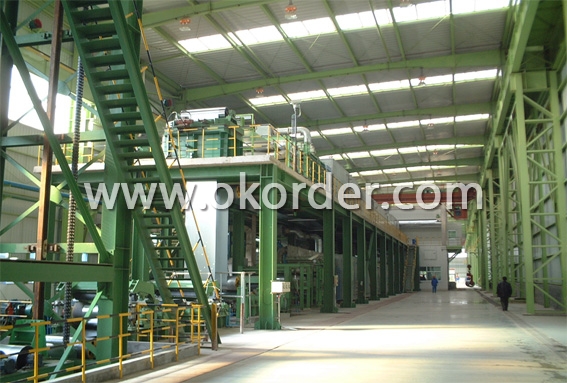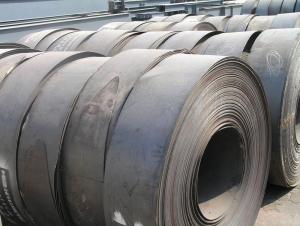Good Quality Hot Rolled Steel GB, 60mm-100mm
- Loading Port:
- China Main Port
- Payment Terms:
- TT or L/C
- Min Order Qty:
- 50 tons m.t.
- Supply Capability:
- 50000 Metric Tons Per Month m.t./month
OKorder Service Pledge
OKorder Financial Service
You Might Also Like
Specification Of Good Quality Hot Rolled Steel GB, 60mm-100mm
|
|
Thickness |
Width |
Length |
Coil Inside Diameter |
|
HOT ROLLED STEEL COIL |
1.50~25.0mm |
600~2000mm |
|
762mm |
|
HOT ROLLED STEEL STRIP |
1.50~20.0mm |
30~720mm |
|
762mm |
|
HOT ROLLED STEEL PLATE |
6.00~700mm |
500~4500mm |
4000~18000mm |
|
|
HOT ROLLED STEEL SHEET |
1.20~25.0mm |
50~2000mm |
0~18000mm |
|
|
HOT ROLLED STEEL CHEQUERED |
1.40~10.0mm |
900~1500mm |
0~18000mm |
|
Standard &Grade of Good Quality Hot Rolled Steel GB, 60mm-100mm
|
|
JIS |
ASTM |
SAE |
EN |
|
Commercial Quality |
G3131 SPHC |
A569 A635 A659 A1011 CS Type A, B, C |
1006~1025 |
10111 DD11 |
|
Drawing Quality |
G3131 SPHD |
|
1006~1010 |
10111 DD12 |
|
Deep Drawing Quality |
G3131 SPHE |
A622 A1011 DS Type A, B |
1006~1010 |
10111 DD13 DD14 |
|
General Structure (T.S.<490N/mm2) |
G3101 SS330 SS400 G3106 SM400A G3132 SPHT1 SPHT2 SPHT3 |
A36 A283 GR.C A570 GR.30~40 A1001 SS GR.30~40 |
1010~1025 |
|
|
General Structure (T.S.≥490N/mm2) |
G3101 SS490 G3106 SM490A SM490YA G3132 SPH4 |
A570 GR.45~50 A607 GR.45~70 A1011 SS GR.45,50 A1011 HSLAS GR.45~70 |
J1392 050X |
|
Definition of Good Quality Hot Rolled Steel GB, 60mm-100mm
Rolled to its final dimensions while it’s hot enough to scale, our hot-rolled steel is an amalgamation of the various qualities of steel. It can be in the form of plates, sheets and coils. Our Hot-Rolled Steel Sheets and Coils are applied to a wide range of uses such as automobile, electrical appliance, machinery manufacturing, container manufacturing, shipbuilding, bridge, pipeline, and receive high acclaim from our customers for its excellent quality.


Usage/Application Of Good Quality Hot Rolled Steel GB, 60mm-100mm
As raw material for:
Container &Pipe Production
Carbon Structural Steel
Low Alloy Steel
High Quality Carbon Structural Steel
Atmospheric Corrosion Resistant Steel
Low Carbon Steel (Commercial Quality, Drawing Quality, Deep Drawing Quality)
Packaging & Delivery of Good Quality Hot Rolled Steel GB, 60mm-100mm
The packing of coils consists of anti-damp paper, PVC film, hardboard paper, steel box, strapped with steel strips, fitted with locks and edge protectors and guarantees the optimal condition of the delivered goods. Each coil can be additionally fitted with wooden/steel skids(eye to the side) or wooden pallets(eye to the sky).
Bulk shipment packed with steel belt.

- Q: What are the different types of steel products used in the manufacturing of electronics?
- Some of the different types of steel products used in the manufacturing of electronics include stainless steel, carbon steel, and electrical steel. Stainless steel is often used for its corrosion resistance and durability, particularly in components such as casings and connectors. Carbon steel is commonly utilized for structural components and enclosures due to its strength and affordability. Electrical steel, which includes silicon steel and nickel-iron alloys, is specifically designed for use in electromagnetic applications such as transformers and motors.
- Q: What are the applications of steel grating in industrial platforms?
- Steel grating has various applications in industrial platforms due to its durability, strength, and versatility. It is commonly used as flooring material in industrial platforms to provide a secure and stable surface for workers. Steel grating offers excellent load-bearing capacity, allowing it to withstand heavy equipment, machinery, and foot traffic. Additionally, it provides effective drainage and ventilation, preventing the accumulation of water, debris, and hazardous gases. Its anti-slip properties further enhance worker safety in industrial environments. Overall, steel grating is essential in creating robust and reliable platforms that optimize productivity and safety in industrial settings.
- Q: What are the different types of steel roofing materials?
- There are several types of steel roofing materials available, including corrugated steel, standing seam steel, and stone-coated steel.
- Q: What is the importance of steel reinforcement in concrete structures?
- The steel reinforcement in concrete structures is crucial because it enhances the strength and durability of the concrete. It helps to resist tensile forces that concrete alone cannot withstand, such as bending, cracking, and stretching. Steel reinforcement also improves the overall structural integrity of the concrete, ensuring that it can withstand heavy loads and external pressures. Additionally, it helps to prevent potential structural failures and increases the lifespan of the concrete structure.
- Q: How is steel used in the production of construction machinery and equipment?
- Steel is used in the production of construction machinery and equipment due to its strength, durability, and ability to withstand heavy loads. It is commonly used to manufacture structural components such as frames, chassis, and bodies, as well as essential parts like gears, tracks, and hydraulic components. The high tensile strength of steel ensures the machinery can handle the rigorous demands of construction sites and provides a long-lasting solution for reliable and robust equipment.
- Q: How do steel products contribute to the automotive aftermarket industry?
- Steel products contribute significantly to the automotive aftermarket industry by being fundamental components in the production and repair of vehicles. From body panels and frames to engine parts and suspension components, steel is widely used due to its strength, durability, and affordability. Steel products also play a crucial role in ensuring safety by providing structural integrity to vehicles. Overall, steel's contribution to the automotive aftermarket industry is vital in maintaining and enhancing the quality, performance, and reliability of vehicles.
- Q: What are the different types of steel wires and their applications in the automotive industry?
- There are several types of steel wires used in the automotive industry, each with its specific applications. Some common types include high carbon steel wire, stainless steel wire, and galvanized steel wire. High carbon steel wire is known for its strength and durability, making it suitable for applications in the suspension system, seat frames, and brake systems. Stainless steel wire, on the other hand, provides excellent corrosion resistance and is often used in exhaust systems, fuel lines, and other components that are exposed to harsh environments. Galvanized steel wire is coated with a protective layer of zinc, making it resistant to rust and corrosion. This type of wire is commonly used in applications such as springs, cables, and reinforcements for various automotive parts. Overall, steel wires play a crucial role in enhancing the strength, stability, and safety of automotive components, contributing to the overall performance and reliability of vehicles.
- Q: What are the different types of steel products used in the manufacturing of medical equipment?
- The different types of steel products used in the manufacturing of medical equipment include stainless steel, carbon steel, and alloy steel. Stainless steel is widely used due to its corrosion resistance, strength, and ease of sterilization. Carbon steel is used for components that require high strength and durability, while alloy steel is utilized for specialized applications that require specific properties such as high temperature resistance or magnetic properties.
- Q: How are steel forgings used in the aerospace industry?
- Steel forgings are used in the aerospace industry for various critical components such as landing gear, engine parts, turbine discs, and structural components. These forgings offer superior strength, durability, and resistance to high temperatures, making them ideal for withstanding the extreme operating conditions of aircraft. With precise shaping and rigorous quality control, steel forgings ensure the safety and reliability of aerospace systems.
- Q: What are the advantages of using stainless steel in food processing?
- There are several advantages of using stainless steel in food processing. Firstly, stainless steel is highly resistant to corrosion, ensuring that it does not react with the food or contaminate it with harmful substances. Secondly, it is easy to clean and maintain, allowing for effective sanitation and reducing the risk of bacterial growth. Additionally, stainless steel is a strong and durable material that can withstand high temperatures, making it suitable for various food processing applications. Lastly, stainless steel is non-porous, preventing the absorption of odors, flavors, or stains, and ensuring the purity and quality of the food being processed.
1. Manufacturer Overview
| Location | Shandong, China |
| Year Established | 1958 |
| Annual Output Value | |
| Main Markets | Mid East Northern Europe North America Eastern Asia Africa Eastern Europe Southeast Asia Western Europe Southern Europe |
| Company Certifications | ISO 9001 |
2. Manufacturer Certificates
| a) Certification Name | |
| Range | |
| Reference | |
| Validity Period |
3. Manufacturer Capability
| a) Trade Capacity | |
| Nearest Port | Tianjin; Qingdao |
| Export Percentage | 80% |
| No.of Employees in Trade Department | 100People |
| Language Spoken: | English; Chinese; Korean |
| b) Factory Information | |
| Factory Size: | |
| No. of Production Lines | |
| Contract Manufacturing | OEM Service Offered; Design Service Offered |
| Product Price Range | Average |
Send your message to us
Good Quality Hot Rolled Steel GB, 60mm-100mm
- Loading Port:
- China Main Port
- Payment Terms:
- TT or L/C
- Min Order Qty:
- 50 tons m.t.
- Supply Capability:
- 50000 Metric Tons Per Month m.t./month
OKorder Service Pledge
OKorder Financial Service
Similar products
Hot products
Hot Searches
Related keywords



























